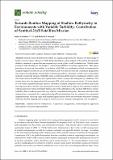Por favor, use este identificador para citar o enlazar a este item:
http://hdl.handle.net/10261/224124COMPARTIR / EXPORTAR:
 SHARE SHARE
 CORE
BASE CORE
BASE
|
|
| Visualizar otros formatos: MARC | Dublin Core | RDF | ORE | MODS | METS | DIDL | DATACITE | |

| Título: | Towards Routine Mapping of Shallow Bathymetry in Environments with Variable Turbidity: Contribution of Sentinel-2A/B Satellites Mission |
Autor: | Caballero, Isabel CSIC ORCID; Stumpf, Richard P. | Palabras clave: | Satellite-derived bathymetry Copernicus programme Multi-temporal approach Atmospheric correction Lidar Turbidity |
Fecha de publicación: | 1-feb-2020 | Editor: | Multidisciplinary Digital Publishing Institute | Citación: | Remote Sensing 12(3): 451 (2020) | Resumen: | Satellite-Derived Bathymetry (SDB) has significant potential to enhance our knowledge of Earth’s coastal regions. However, SDB still has limitations when applied to the turbid, but optically shallow, nearshore regions that encompass large areas of the world’s coastal zone. Turbid water produces false shoaling in the imagery, constraining SDB for its routine application. This paper provides a framework that enables us to derive valid SDB over moderately turbid environments by using the high revisit time (5-day) of the Sentinel-2A/B twin mission from the Copernicus programme. The proposed methodology incorporates a robust atmospheric correction, a multi-scene compositing method to reduce the impact of turbidity, and a switching model to improve mapping in shallow water. Two study sites in United States are explored due to their varying water transparency conditions. Our results show that the approach yields accurate SDB, with median errors of under 0.5 m for depths 0–13 m when validated with lidar surveys, errors that favorably compare to uses of SDB in clear water. The approach allows for the semi-automated creation of bathymetric maps at 10 m spatial resolution, with manual intervention potentially limited only to the calibration to the absolute SDB. It also returns turbidity data to indicate areas that may still have residual shoaling bias. Because minimal in-situ information is required, this computationally-efficient technique has the potential for automated implementation, allowing rapid and repeated application in more environments than most existing methods, thereby helping with a range of issues in coastal research, management, and navigation. | Descripción: | This article belongs to the Special Issue Coastal Waters Monitoring Using Remote Sensing Technology. | Versión del editor: | http://doi.org/10.3390/rs12030451 | URI: | http://hdl.handle.net/10261/224124 | DOI: | 10.3390/rs12030451 | Identificadores: | e-issn: 2072-4292 |
| Aparece en las colecciones: | (ICMAN) Artículos |
Ficheros en este ítem:
| Fichero | Descripción | Tamaño | Formato | |
|---|---|---|---|---|
| remotesensing-12-00451-v2.pdf | 5,27 MB | Adobe PDF |  Visualizar/Abrir |
CORE Recommender
SCOPUSTM
Citations
75
checked on 29-abr-2024
WEB OF SCIENCETM
Citations
63
checked on 23-feb-2024
Page view(s)
107
checked on 30-abr-2024
Download(s)
168
checked on 30-abr-2024
Google ScholarTM
Check
Altmetric
Altmetric
Este item está licenciado bajo una Licencia Creative Commons

